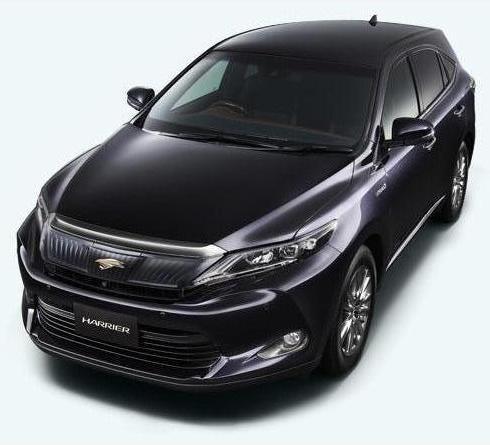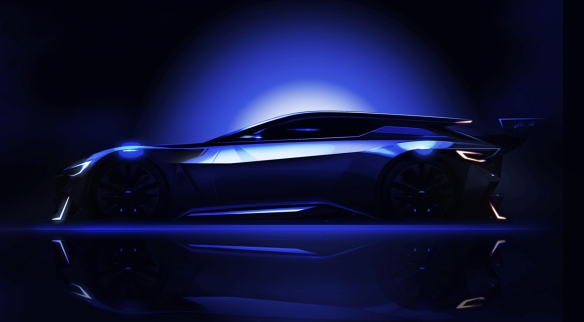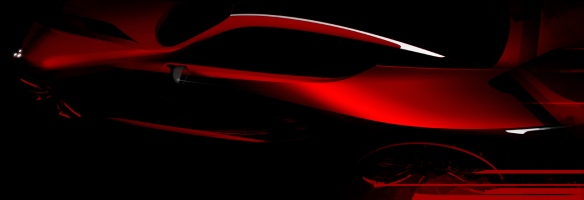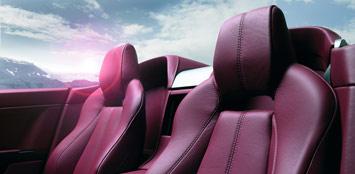
A bare-bones Japanese language Toyota news release linking to a page on the Toyota Japan website promising a new Harrier crossover SUV in winter 2013 led to a stream of predictions that we were looking at the 4th-generation of the Lexus RX – minus the spindle grille – based on the historic relation between the two models. And this was no mere shadowy teaser, but included 4 clear pictures of a dark violet-blue-gray vehicle (three of which illustrate this article) with clear stylistic ties to its predecessors.
So, are they correct, or off base? OK, so the title of this article is a huge, in-your-face giveaway spoiler as to what this author thinks, but please stay with us as we justify why our opinion flies in the face of much of the Internet punditry. After all, yours truly has been down this road before – almost 9 years ago, to be precise – debunking erroneous notions that the original Toyota Mark X was the 2nd-generation Lexus IS.
First, though, a review of the historic relation between essentially similar Lexus and Toyota models is in order. In terms of origins, these fall into two broad categories:
Conceived as a Lexus, but badged as a Toyota in Japan
Born of the F1 (“Flagship One”) initiative to create a large luxury vehicle to challenge the world’s best, the original Lexus LS launched Toyota’s international luxury brand, with sales starting in the United States in September 1989. With the Lexus brand not appearing in the Japanese market until 26 July 2005, however, there was an almost 16-year period which saw an at times convoluted relationship between the international Lexus models and their Toyota-badged variants for Japan. Japanese dealers began clamoring for their version of the Lexus LS, which appeared at Toyopet Stores barely a month after its U.S. debut bearing the Toyota Celsior badge. The late 2006 debut of the XF40 4th-generation Lexus LS saw the end of Toyota Celsior badging.
A high-end luxury sedan begs for a GT coupe counterpart, right? Thus work began on the E-segment Lexus SC at Toyota’s Calty Design Research center in California, leading to a June 1991 unveiling. In Japan it appeared around the same time as the 3rd (Z30) iteration of a familiar badge: Toyota Soarer. The Soarer name carried on into the Japanese version of the 2nd-generation (Z40) Lexus SC until the July 2005 Japanese rollout of the Lexus dealer network. Then, the Toyota Soarer simply changed badges and carried on as a Lexus until its ultimate demise as a production car in July 2010 and as a Super GT racer at the end of the 2011 season.
Toyotas rebadged as Lexus for export
Toyota soon realized that a single F-segment high-end large luxury sedan such as the Lexus LS / Toyota Celsior was not enough to sustain a dealer network, and hastily adapted the V20 (2nd-generation) Toyota Vista 4-door pillared hardtop (itself a Toyota Camry variant) as the original Lexus ES 250. This 2-year stopgap was replaced by the XV10 2nd-generation Lexus ES with a new Toyota Windom equivalent. Both were launched in September 1991. The ES/Windom relation continued until the debut of the XV40 5th-generation Lexus ES in February 2007, at which point the Toyota Windom died and the Lexus ES became a model built but not sold in Japan.
After the rear-wheel-drive F-segment Lexus LS sedan and the E-segment Lexus SC coupe, an E-segment sedan seemed like a natural next step for Lexus. After Calty designer Erwin Lui’s unorthodox tactic of using plaster-filled balloons to achieve the original SC coupe’s rounded, voluptuous shapes, Toyota did something just as unexpected: hire Italy’s famed Italdesign Giugiaro to design a new Crown derivative, the Toyota Aristo, which was unveiled in Japan in October 1991. Its Lexus GS counterpart for export began production in February 1993. The twin Aristo/GS continued for a second generation, known as S160, until the introduction of the 3rd-generation (S190) Lexus GS at the January 2005 Detroit Auto Show and the Japanese introduction of the Lexus brand over 6 months later killed the Toyota Aristo.
Lexus’ first foray into the world of sports utility vehicles was with the Lexus LX line, essentially fancier, high-luxe versions of the largest Toyota Land Cruisers, starting with the 1996 model year only for export. In a notable twist, however, the 2nd-generation (J100) Lexus LX was sold in Japan as the Toyota Land Cruiser Cygnus. The Cygnus badge didn’t survive past the 2007 model year.
The increasing popularity of European-style, enthusiast-friendly D-segment sports sedans led to the creation of the iconic Toyota Altezza in October 1998. The following year, its Lexus IS-badged counterpart first appeared in Europe. Alas, the original Altezza/IS lasted but a single generation, and the Altezza badge was laid to rest in March 2005 with the advent of the 2nd-generation (XE20) Lexus IS (although we once wondered if the Altezza badge was worthy of reviving).
Yes, just about every Toyota-badged Lexus introduced before 2005 has been relegated to history, with one exception…

Harrier: the last remaining Toyota-to-Lexus model
Although previewed in concept form by the Lexus-badged SLV, the world’s first D-segment luxury crossover (car-based) SUV actually first went into production as the Toyota Harrier in December 1997, 3 months before being exported as the Lexus RX. Harrier and RX were near-identical twins during their first (XU10) and second (XU30) generations, the latter having first gone on sale in February 2003. As the 3rd-generation (AL10) Lexus RX appeared in November 2008 and finally entered Japanese showrooms, Toyota chose not to discontinue the Harrier. Rather, it carried on, virtually unchanged, in the Japanese domestic market, a fact that slipped under many radars.
In a sense, the seeds for this story were sown back in December 2012, when yours truly, researching something on the Toyota Japan site, accidentally stumbled upon a now dead Harrier page. If memory serves correctly, it was then available only with a single engine offering: the 2AZ-FE 2.4-liter 4-cylinder engine, a fact tacitly confirmed by the Batfa.com website.
Thus, Japanese consumers have, in a sense, the option of choosing between showroom-new 2nd-gen or 3rd-gen Lexus RXs, with the former bearing a Toyota badge and using a smaller, less powerful engine. Such a situation isn’t as unusual as you’d expect. Volkswagen is probably the champion in this regard, with buyers in China, Mexico and South Africa, off the top of our head, able to choose from multiple generations of Golfs, Jettas and Passats off the new car showroom floor. It isn’t unusual for European carmakers such as Opel, Fiat and Peugeot/Citroën to offer, for a period, decontented cheaper versions of soon-to-be-superseded models alongside their better-equipped, more expensive successors. And, in North America, Chevrolet has been known to continue building older versions of Malibus and Impalas for fleet and rental markets alongside the newer consumer-oriented versions.
With Toyota having chosen to continue offering the Harrier in Japan and the current version having remained virtually unchanged for over a decade, it’s no wonder we’re now looking at a successor. Just how much do we know at this point, though?
Hybrid-only or not?
Although recently down to a single 4-cylinder gasoline engine choice, the Toyota Harrier has previously offered the options of the 1MZ-FE 3-liter V6 and the gasoline-electric hybrid version of its larger 3MZ-FE 3.3-liter V6 sibling. It takes only the barest of glances to spot the prominent HYBRID badges on the front fenders of the newest Harrier, so we’re definitely seeing the return of the Harrier Hybrid. But will the Harrier go hybrid-only for the next generation? Hard to say for sure, but there’s certainly a strong case that it could. For one, the latest 7th-generation (XV50) Toyota Camry for the Japanese market has evolved into a niche Hybrid-only vehicle, the largest such front-wheel-drive model in Toyota’s domestic stable. Further, none of the Japanese domestic market’s crossover SUVs currently offer a hybrid version. The Highlander/Kluger? That hasn’t been sold in Japan since the advent of the second generation in mid-2007. The RAV4? The newest 4th-generation version has yet to go on sale there even with gasoline engines, let alone as a hybrid that the rumor mill says is an iffy proposition. And what about the other Toyotas conceptually closest to the Harrier: the American Venza and its similarly-styled smaller Japanese sibling, the Mark X Zio? Nope, no hybrids there, either.
And what powertrain would a Harrier Hybrid use? Our best guess is the 2.5-liter 2AR-FXE 4-cylinder unit from the latest Camry Hybrid.
Facelift or all-new sheetmetal? A brief styling analysis.
Looking at the new Harrier, especially the side view and greenhouse, is giving us a very strong case of déjà vu. Is this all-new sheetmetal? Or simply an extensive facelift on the existing Harrier akin to those applied to the current 4th-generation Lexus LS for 2013 or to the previous 3rd-generation Toyota Avalon for the 2011 and 2012 model years?
The fixed glass pane on the trailing edge of the rear doors is more akin to the outgoing Harrier/2nd-gen Lexus RX than to the latest RX, which replaces this glass with a thicker C-pillar. Yet, details such as the greenhouse and side window shapes, fender and lower door sill shapes and sculpturing appear closer but hardly identical to the latest Lexus RX. Thus, we’ll conclude that we’re looking at new sheet metal, albeit styled in a very familiar way.
 Up front is where the Harrier shows the most marked departure from its predecessor. Beneath the prominent chrome brow on the leading edge of the hood is an upper grille that, to this author, looks like a translucent throwback to the late 1980s-to-mid 1990s light bars found on Mercury Sable and Pontiac Grand Prix models of the era. The shape of the large lower grille follows current Toyota styling trends, and is especially reminiscent of the latest Avalon. Pretty distant from the current Lexus spindle grille look, we’d say.
Up front is where the Harrier shows the most marked departure from its predecessor. Beneath the prominent chrome brow on the leading edge of the hood is an upper grille that, to this author, looks like a translucent throwback to the late 1980s-to-mid 1990s light bars found on Mercury Sable and Pontiac Grand Prix models of the era. The shape of the large lower grille follows current Toyota styling trends, and is especially reminiscent of the latest Avalon. Pretty distant from the current Lexus spindle grille look, we’d say.
When is the 4th-gen Lexus RX due, anyway?
Writers speculating on whether we’re about to see a new Lexus RX are ignoring that model’s product cadence. The 3rd-generation went on sale in February 2009 as a 2010 model and received the larger spindle grille as part of a mid-life facelift in Spring/Summer 2012 for the 2013 model year. Thus, we’d be quite surprised if a 4th-generation RX appeared any sooner than late 2014 or during the 2015 calendar year as a 2016 model. Besides, Lexus’ current priorities are launching its 2 newest model lines, the RC coupe and the NX smaller crossover SUV.
Any hopes for a Toyota Harrier/Lexus RX reconvergence? Sorry, but that train left in early 2009, and this new Harrier, if anything, shows that its path is veering further than ever from that of its formerly near-identical twin.































